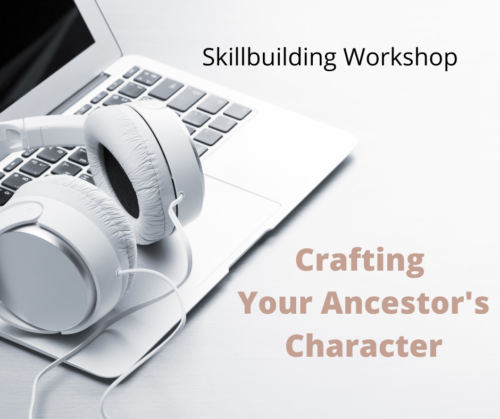Where Do I Start?
2 thought on “Where Do I Start?”
Comments are closed.
Related Post

How to Begin Your StoryHow to Begin Your Story
Without a great beginning, a beginning that draws the reader in and hooks them your story is dead. The beginning becomes especially important in a family history narrative. We all know how difficult it can be to get our relatives to read about their family history. They may not have a particular interest in their history; maybe you forced them into reading this story, perhaps some guilt is involved. Regardless, how they got to that first page you want to be sure they stay, and they stay because they are intrigued.
The beginning is the start of your story up until your first plot point. The first plot point being the event that causes your ancestor to take action and set them on a path to their goal. This first plot point is often referred to as the inciting incident or the first turning point.
There is no tried and true answer to where to begin. Throw out the idea that your family history must start at the beginning of a life, in chronological order. Look at your research, your ancestor’s story and find a moment, event, question or surprise that you feel will grab your reader’s attention. Your story’s beginning should set the tone and mood, establish a point of view and make the author’s voice heard (that’s you).
A Checklist for the Beginning of Your Story
- A Hook – the opening lines, the first moments of your story that grabs the reader’s attention, that captures your reader’s curiosity and propels them to keep reading.
The hook can come in a variety of ways:
- Start with a question – put a question in your reader’s minds. Make them wonder what does this have to do with my ancestor, my family history. How is my ancestor going to get out of this situation?
- Begin at a crucial moment – Choose a critical juncture in your family history, an event that captures your reader’s attention and will encourage them to learn what happens next.
- Create an interesting picture – Start your family history with description that helps your reader’s paint a picture of their ancestor’s setting. Put them in a scene, give them some action and your reader will be drawn in.
- Introduce an intriguing character– A character that grabs your reader’s attention will encourage them to stay to find out more. Let your ancestor’s personality take the lead.
- Start with an unusual situation – Show us your ancestor in a unique situation that makes your family take notice, and they’ll be sticking around to see what it’s all about.
With each passing sentence, you want to continue to build, coaxing the reader to stay with you. Each paragraph should build on the last, pulling them deeper until they can’t turn back. The last sentence of each paragraph should be a catalyst to the next. We all remember a book that we couldn’t put down. The authors of these books excelled at creating great beginnings that drive you forward into the story.
Besides the hook, the start of your family history story should offer the reader other elements that will help capture their attention and curiosity.
- Introduce the Protagonist – Introduce us to the Protagonist Ancestor if you haven’t done so in the hook. Assist the reader in establishing a relationship with your primary character.
- Establish the Setting – The reader should be able to visualize where the story takes place, area, time and even season.
- Introduce the Antagonist – Introduce us to the Antagonist Ancestor ( if there is one). Keep it brief, don’t give us everything up front.
- Introduce a Story Question – Present the reader with a challenge that your ancestor faces. Have your readers asking the question, How will they overcome this challenge?
- Theme – Introduce, your reader to the theme of your family history story. Give them something to think about, what does your family history mean?
What Your Beginning Shouldn’t Include
- Avoid backstory or flashbacks. Stay in the present story. There is plenty of time to add historical information later.
- Too much description, particularly of the central character, give us just enough to paint a picture, not a long drawn out description. Stick to unique and very specific details. It’s important to remember, in this case, more is not necessarily better.
- Don’t introduce too many characters.
- Don’t change point of views between characters, too confusing this early on. If you are writing your family history from the point of view of two ancestors, let the reader get comfortable with one point of view before changing.
- Too many locations, keep your beginning limited to one or two locations. Ancestors travelled but let’s not have them in a dozen different places in the first chapter.
- Don’t spoon-feed the reader, giving everything they need to know about their family history upfront. You’re writing this story to share a family history in a compelling read. Make them hang with you until the end, don’t share everything in the first chapter.
- Prologues – much debated, but personally I dislike books that start with a prologue because they are often a place to dump backstory and it often feels lazy. It’s a personal choice; prologues are best used to raise a question in the reader’s mind about the main character.

How to Write a Family History Short Story in 10 StepsHow to Write a Family History Short Story in 10 Steps
Family stories don’t have to be epic novels or mammoth books that tell a tale from birth to death of ancestors and their families. They can be short stories.
What is a Short Story?
A short story is when a character undergoes some event and experiences something which offers him change. Short stories usually say something a small something but delivered with precision.
Short stories are growing in popularity because they can deliver the same experience of a novel but can be consumed quickly. You can post them on a blog, in a family newsletter or turn them into a video or gather a bunch of them together into a short story collection.
A short story is not a life to death tale of an ancestor squeezed into a short time period. But instead a moment in an ancestor’s life in which he or she experiences a life-changing event.
A short story does not have a 3-act structure as we learn in our online class Plotting a Family History Story. Nor is it just Act 1, 2, or 3. It has its own individual structure.
It focuses on your protagonist ancestor. There is usually one conflict two at the most. There are generally no more than two to four characters. The story may transpire over one or two locations.
In a short story, you have less space to develop your ancestor’s character, less room for lengthy dialogue.
A short story is rarely over 10,000 words or below 500 words, commonly between 1500-5000 words. A short story can be read in a single-sitting but long enough to engage and move the reader. The topic is narrow and focused, the story’s meaning demonstrated through events that effect some change or denial of change in an individual.
We’ve broken down the process of writing a family history short story into 10 steps.
10 Steps to a Short Story
Step 1: Brainstorm
Brainstorm. Choose an exciting event from your research. It could be a happy moment or sad moment or a life-changing event. It could focus on a relationship between two ancestors or with a friend, acquaintance, stranger or spouse. It could be a trip or vacation, a sporting event or other activity. Mine your research and find an event worthy of a short story.
Step 2: Choose the Protagonist Ancestor
Choose the ancestor through whose perspective the story will be told. Every story needs a protagonist ancestor at the centre of the story. This allows the reader to connect with that ancestor and the story.
Step 3: Find the Story Goal
Before you start any story short or long you must identify the focus, the goal. All narratives have a focal point, a climax. Identify a purpose that your protagonist ancestor sought to achieve in his life. What is the central moment of the story when your ancestor reaches this goal and change occurs? This is the climax, the goal of your narrative.
Step 4: Complete Ancestor Profile and Setting Details
Outline your ancestor’s profile and the setting details. It’s important to take some time to research and flesh out the details and descriptions of the setting of your story so that you can bring it to life on the page. Equally important is understanding your protagonist ancestor on an in-depth level. Complete an ancestor profile so that you can pull together your ancestor’s physical appearance but also come to comprehend what makes them tick and you are able to bring the most authentic ancestor to the page.
Step 5: Write the story as a one-page synopsis.
Go ahead and briefly sketch out a 1-page synopsis of your story as you see it. This will help you in the next step of creating a storyline.
Step 6: Outline the story structure using a storyline.
Below you’ll find a storyline for a short story. You want to break down your narrative into critical scenes, including opening scene, obstacles, climax and closing scene.
Step 7: Write your short story using scene and summary.
You’re now ready to write your short story. Make sure you find a delicate balance of scenes and summary to tell an intriguing tale that will bring an engaging and entertaining story to the page.
Step 8: Write a satisfying ending.
Make sure your story ends with a climax and conclusion that leaves your reader with a clear image and message.
Step 9: Rewrite for clarity, concision and structure.
Now it’s time to rewrite, making sure every detail is exact. Share your story with a writing group. Get feedback and allow that feedback to grow your writing skills.
Step 10: Share your writing with the world.
Now your story is ready to share with the world. Stories are meant to be read. Be brave and put it out in the world. Then, move on to the next story.
Need a short story example? One of the first short stories I ever read is Faulkner’s ‘A Rose for Emily.’ Go ahead and give a read and note how Faulkner has structured his story. While this is a fictional short story, I offer it up as a great example of short story writing structure.


Thank you Lyn: I am happy to receive your videos.
Thank you Lynne for all you do. These snippets of information are so helpful and easy to digest, a little at a time. I’m really enjoying putting Rebecca’s story together.